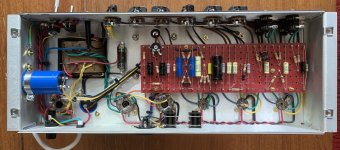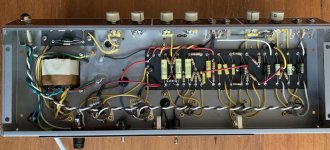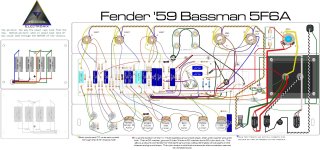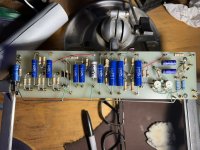First of all I promised I would post some pics of a JTM45 I just finished once I received the replacement OT from Mercury Magnetics. I had received a DOA OT from them which is kind of unusual. But now it's done, short of building a cabinet to put it in. It will be as small as 1x12 combo with a Celestion G12H as I can make it. I'll be using solid pine and a tweed style baffle because I love the sound of that style of cabinet. Plus it's lighter than your typical Marshall style birch ply cab. And a JTM45 is really a tweed circuit anyway...

I use a slight variation on the typical Marshall grounding scheme. I don't solder the buss wire to the back of the pots because that creates ground loops and hum. I solder them only the the lug on the pot that goes to ground and then connect the buss wire to a point on the chassis just behind the first volume pot. You can see in the pic a brass nut just behind the normal channel's pot - that's it. As a result there is no hum coming from the amp. If you listen closely there is a hint of white noise when the volume is at playing levels. If you crank the amp there is more white noise but I'm ok with that.
All the hardware came from Valvestorm. Transformers are Mercury Magnetic and anything else came from Antique Electronic. I love the holey turret board.
And here is a 6G3 Brown Deluxe I also built recently. I was inspired to build this after playing a Suhr Hombre in a store recently. It's a great sounding amp. I had built a 6G3 a few years ago but I swear this one sounds better. I'm not sure what I did differently.

@RetiredUnit1 will be pleased - no cloth covered wire! Ok there might be one piece... But mostly it's PVC coated multi strand pre-tinned wire. I followed Mr Psionic Audio's recommendations on grounding, including the use of a massive soldering iron to do the grounds near the PT. As a result the amp is actually hum-free at playing levels. In fact when a friend came around to try it yesterday he didn't even realise it was on and got a shock when I turned the tuner off and his guitar strumming was suddenly loud. This is why I love to continually learn this stuff. You can always improve.
Chassis, fibreboards and faceplates are Mojotone. Transformers MM, and all other parts Antique Electronics. I added a BF style bias pot, which needed a little tweaking to work with the 6G3 circuit. Otherwise it's actually pretty stock. I did swap a tremolo cap to slow the trem down a little, but that's a fairly common mod. I accidentally tore the paper at the top of the PT while installing it so used some masking tape to stop it tearing any further.
Also added a NFB switch right by the speaker out. At my usual playing volumes removing the NFB sounds great - a bit like a Loudness switch on an old hifi. It adds lows and highs and a bit of liveliness. But when you want to crank the amp having the NFB in place helps it to not get too ragged. Having the switch is cool.
Once I have a cab for this I can see myself using it a lot. I'm currently playing it through my 5E3 cab so it should sound much the same in its own cab. It's very similar to the 5E3 but has a little more midrange and headroom. And the tremolo is as good as tremolo gets.
I love how easy it is to get quality parts to build these amps these days. I would encourage anyone who has the inclination to try building themselves an amp because once you learn how to do it shop-bought amps won't cut it anymore!

I use a slight variation on the typical Marshall grounding scheme. I don't solder the buss wire to the back of the pots because that creates ground loops and hum. I solder them only the the lug on the pot that goes to ground and then connect the buss wire to a point on the chassis just behind the first volume pot. You can see in the pic a brass nut just behind the normal channel's pot - that's it. As a result there is no hum coming from the amp. If you listen closely there is a hint of white noise when the volume is at playing levels. If you crank the amp there is more white noise but I'm ok with that.
All the hardware came from Valvestorm. Transformers are Mercury Magnetic and anything else came from Antique Electronic. I love the holey turret board.
And here is a 6G3 Brown Deluxe I also built recently. I was inspired to build this after playing a Suhr Hombre in a store recently. It's a great sounding amp. I had built a 6G3 a few years ago but I swear this one sounds better. I'm not sure what I did differently.

@RetiredUnit1 will be pleased - no cloth covered wire! Ok there might be one piece... But mostly it's PVC coated multi strand pre-tinned wire. I followed Mr Psionic Audio's recommendations on grounding, including the use of a massive soldering iron to do the grounds near the PT. As a result the amp is actually hum-free at playing levels. In fact when a friend came around to try it yesterday he didn't even realise it was on and got a shock when I turned the tuner off and his guitar strumming was suddenly loud. This is why I love to continually learn this stuff. You can always improve.
Chassis, fibreboards and faceplates are Mojotone. Transformers MM, and all other parts Antique Electronics. I added a BF style bias pot, which needed a little tweaking to work with the 6G3 circuit. Otherwise it's actually pretty stock. I did swap a tremolo cap to slow the trem down a little, but that's a fairly common mod. I accidentally tore the paper at the top of the PT while installing it so used some masking tape to stop it tearing any further.
Also added a NFB switch right by the speaker out. At my usual playing volumes removing the NFB sounds great - a bit like a Loudness switch on an old hifi. It adds lows and highs and a bit of liveliness. But when you want to crank the amp having the NFB in place helps it to not get too ragged. Having the switch is cool.
Once I have a cab for this I can see myself using it a lot. I'm currently playing it through my 5E3 cab so it should sound much the same in its own cab. It's very similar to the 5E3 but has a little more midrange and headroom. And the tremolo is as good as tremolo gets.
I love how easy it is to get quality parts to build these amps these days. I would encourage anyone who has the inclination to try building themselves an amp because once you learn how to do it shop-bought amps won't cut it anymore!
Last edited:





